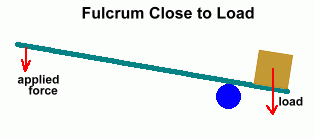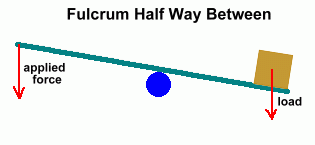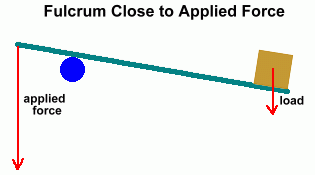 A lever is a solid object used to transfer force. It can increase the force that is applied, or make something move in a different direction, or through a greater distance. It can be used to lift something that is far away. You've used many levers in your life without knowing it. This page will tell you how they work, and show you some examples. - The applied force is the force you use to move the lever. - The load is a force which must be overcome by the lever. - The fulcrum is the point around which the lever rotates. Where these three features of a lever are situated in relation to each other determines what type of lever you have, and what it can do, as we'll see below. Let's look at a very simple lever first, and describe the kinds of jobs a lever can do.  Here is a lever set up to move a heavy load. This is one of the main uses of a lever. The fulcrum is placed close to the load, and this will let you move the load with just a small applied force. Using a lever this way gives you mechanical advantage, which just means that the force you apply gets multiplied, so you can put a large force on the load. The disadvantage of using a lever like this is that you have to apply a force over a large distance, and the load itself will move only a short distance. But you can use it to move large loads that you wouldn't ordinarily be able to budge, even if they don't move very far.  Here's a similar lever, but now the fulcrum is exactly half way between the load and where you apply the force.
Here's a similar lever, but now the fulcrum is exactly half way between the load and where you apply the force.A lever set up this way has no mechanical advantage. Whatever force is necessary to move the load is the force you must apply. You don't get any help. But levers like this are still useful, because they take advantage of another property of some levers: they reverse the direction of the force. You can push in one direction, and the load moves the other way.  Here's the third situation. The fulcrum is nearer the applied force.
Here's the third situation. The fulcrum is nearer the applied force. In a situation like this, you must apply much more force than the force of the load itself. If you're lifting something, it will require much more force than would be needed if you were to just lift the load by yourself. Why would you use a lever if it makes the work harder? The answer is that sometimes we don't care how much force is needed, because we're using a motor. If we have to apply a big force to make the load move, that's OK, because we can let a motor do it. But in the meantime, we've managed to lift a load that is far away, make it move a long distance, and all this with only a small movement where we applied the force. This is a lot to gain, as long as we are willing to apply a very large force with a motor. This is the other thing levers are good for: moving things at a distance. It takes a big force to move the load, but that force can be applied over a small distance ... and it can lift and move loads that are far away, and move them over large distances. O.K., now you've seen what levers can do. Let's look at the three kinds of levers, and what makes each type special. We'll identify some familiar examples too ... |